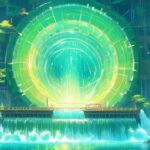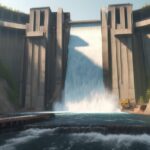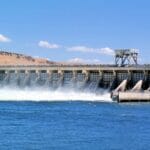Discover the power of nature harnessed for the greater good with our comprehensive guide to 10 essential hydropower facts. As renewable energy continues to gain momentum, it’s crucial to understand the potential of hydropower in transforming our energy landscape. From its technical aspects to environmental impacts, we delve into the key facts surrounding hydropower and explore how it can shape a sustainable future. Join us on this informative journey as we unravel the immense renewable energy potential of hydropower.
Key Takeaways:
- Hydroelectricity is a well-established power source that has been used for many years.
- Hydroelectric dams incorporate fish ladders and elevators to support fish migration.
- Hydropower is considered cost-effective in comparison to other energy sources.
- All states in the US utilize hydropower as an energy source.
- Hydropower is widely regarded as one of the cleanest sources of energy.
- Hydropower is more efficient than fossil fuel-based power generation.
- The Niagara Falls dam was the first dam built in America to harness hydropower.
- Not all dams have the same efficiency and impact in terms of power generation and environmental effects.
- China is home to the largest hydroelectric plant in the world.
- Water contributes to generating 30% of the world’s electricity.
10 Facts About Hydropower

Hydropower, a renewable energy source, has been harnessed for centuries to generate electricity. As an experienced environmental journalist, I am excited to share with you ten fascinating facts about hydropower that shed light on its potential and impact.
Fact 1: Harnessing the Power of Water
Hydropower is the process of converting the energy of moving water, such as rivers or dams, into electricity. This clean and sustainable energy source provides a significant contribution to our global energy needs.
Fact 2: The Fish’s Way
To support fish migration, hydropower dams incorporate fish ladders and elevators. These innovative structures allow fish to safely swim upstream, ensuring their reproductive cycles remain undisturbed even in the presence of dams.
Fact 3: Cost-Effectiveness
One significant advantage of hydropower is its cost-effectiveness. Unlike fossil fuel alternatives, which require continuous fuel consumption, hydropower relies on a renewable resource – water – making it more economically sustainable in the long run.
Fact 4: A Nationwide Commitment
Hydropower is utilized in all states across the United States, highlighting its widespread adoption as a reliable and efficient energy source. It plays a crucial role in meeting the nation’s energy demands and reducing reliance on non-renewable options.
Fact 5: Clean Energy Champion
Hydropower stands proudly among the cleanest energy sources available. Unlike fossil fuels, it produces negligible greenhouse gas emissions, helping combat climate change and reducing the ecological impact of our energy consumption.
Fact 6: Efficiency Unleashed
When compared to traditional fossil fuel power plants, hydropower boasts impressive efficiency rates. This means more energy is generated from the same amount of fuel, minimizing waste and maximizing electricity output.
Fact 7: Niagara Falls Pioneers
The first dam built in the United States was at the majestic Niagara Falls. This historic landmark paved the way for hydropower generation and set the stage for future large-scale projects that tap into the immense power of water.
Fact 8: Dams with Different Outcomes
Not all dams are created equal. While some dams efficiently generate clean energy, others may have a more significant impact on ecosystems and local communities. It is essential to consider each dam’s efficiency and environmental footprint when evaluating hydropower projects.
Fact 9: The Powerhouse of the World
China hosts the largest hydroelectric plant globally, the Three Gorges Dam. This colossal structure generates an impressive amount of electricity, highlighting China’s commitment to utilizing renewable energy sources to meet its growing energy demands.
Fact 10: A Global Energy Contributor
Water is an essential player in the energy game, responsible for generating approximately 30% of the world’s electricity. Hydropower’s significant contribution underscores its vital role in meeting global energy needs sustainably.
As we explore these ten facts about hydropower, it becomes evident that harnessing the power of water offers numerous advantages. From its clean and renewable nature to its cost-effectiveness and efficiency, hydropower stands as a pillar of sustainable energy solutions.
If you’re curious to learn more about hydroelectric energy, click here to discover 10 fascinating facts about this renewable energy source.
For those interested in hydroelectric power, you won’t want to miss out on these 10 facts about hydroelectric power that will astound and enlighten you.
If you’re looking to enhance your knowledge about hydroelectricity, click here to uncover 10 mind-blowing facts about this efficient and sustainable form of energy.
The Different Types of Hydropower Systems

Hydropower is a fascinating and impactful form of renewable energy that harnesses the power of water to generate electricity. With various types of hydropower systems in existence, each with its unique characteristics, it’s important to understand their differences and benefits. In this article, we will explore the different types of hydropower systems and shed light on their significance in our pursuit of sustainable energy sources.
Run-of-River Hydropower
Run-of-river hydropower systems are designed to generate electricity by utilizing the natural flow of a river or stream. Unlike traditional dams that impound large volumes of water, run-of-river projects divert a portion of the river’s flow through a canal or penstock, which directs the water to a turbine. This turbine then spins and converts the kinetic energy of the flowing water into electrical energy.
This type of hydropower system has several advantages. By avoiding the need for a massive reservoir, run-of-river projects have a smaller environmental footprint and a reduced impact on aquatic ecosystems. Additionally, they can quickly respond to changes in electricity demand, making them an efficient and flexible source of renewable energy.
Storage Hydropower
Storage hydropower systems, also known as reservoir hydropower, are the most common type of hydropower plants. These systems involve the construction of large dams that create reservoirs by impounding water. The stored water can be released as needed to generate electricity by flowing through turbines.
One of the remarkable benefits of storage hydropower is its ability to act as a “battery” for the electrical grid. During times of low energy demand, excess electricity from other sources, such as wind or solar power, can be used to pump water from a lower reservoir to a higher one. Then, when electricity demand increases, water is released from the upper reservoir, flowing through turbines and generating power.
Pumped Storage Hydropower
A subset of storage hydropower, pumped storage hydropower works by storing excess electricity generated during low-demand periods by using it to pump water from a lower reservoir to an upper reservoir. Then, during times of high electricity demand, the stored water is released to flow downhill, turning turbines and producing electricity.
Pumped storage hydropower is like an eco-friendly battery. It offers a reliable and efficient method of balancing the electrical grid by providing a rapid-response solution to fluctuations in demand. This technology provides crucial grid stabilization and helps integrate intermittent renewable energy sources.
Offshore Hydropower
While the majority of hydropower projects are located on rivers or in reservoirs, offshore hydropower systems take advantage of the immense power of ocean tides and currents. By using underwater turbines, these systems capture the kinetic energy from tidal movements and convert it into electricity.
Offshore hydropower has the advantage of generating power consistently due to the predictable nature of tides and currents. It is a promising frontier in renewable energy, offering a high energy density and the potential to contribute significantly to the world’s energy needs.
Key Takeaways:
- Run-of-river hydropower harnesses the natural flow of rivers or streams to generate electricity efficiently and with minimal environmental impact.
- Storage hydropower systems use dams to create reservoirs, providing a reliable source of renewable energy and the ability to balance the electricity grid.
- Pumped storage hydropower acts as an electrical energy storage system, using excess electricity to pump water to a higher reservoir and releasing it during peak demand to generate power.
- Offshore hydropower systems capture the power of ocean tides and currents to generate consistent and renewable energy.
Sources:
– International Hydropower Association
– Department of Energy
The advantages and disadvantages of hydropower
Hydropower is a renewable energy source that harnesses the power of flowing water to generate electricity. It has several advantages and disadvantages to consider. Let’s explore them in more detail:
Advantages of Hydropower:
Renewable and Clean: Hydropower is a clean energy source that produces negligible greenhouse gas emissions, making it an environmentally friendly option.
Reliable and Consistent: Hydropower provides a reliable and consistent source of electricity, as water is constantly replenished by the Earth’s water cycle.
Cost-Effective: Over the long run, hydropower is considered an inexpensive source of energy, with lower costs compared to other energy sources.
Multi-purpose Benefits: In addition to electricity generation, hydropower plants offer additional benefits such as flood control, irrigation, and water supply.
Grid Stabilization: Hydropower plays a vital role in stabilizing the electrical grid, providing a consistent power supply and balancing fluctuations in demand.
Integration with Other Energy Sources: Hydropower can be integrated with other renewable energy sources like solar and wind power, enhancing overall energy reliability.
Disadvantages of Hydropower:
Environmental Impact: Building hydropower plants can have negative environmental consequences, including the displacement of wildlife and disruption of natural habitats.
High Upfront Costs: Hydropower projects typically require significant upfront investment and take time to complete, making them a time-consuming and expensive endeavor.
Limited Suitable Locations: Finding suitable locations for reservoirs and dams poses a challenge for expanding hydropower, especially in areas with limited water resources.
Despite these disadvantages, hydropower remains a major contributor to the global renewable energy mix due to its clean, renewable, and reliable nature.
Key Takeaways:
- Hydropower is a renewable and clean energy source that harnesses the power of flowing water to generate electricity.
- It provides a reliable and consistent source of electricity, helping stabilize the electrical grid.
- Hydropower is cost-effective in the long run and offers additional benefits such as flood control and irrigation.
- However, the building of hydropower plants can have negative environmental impacts, and the projects require high upfront costs.
- Limited suitable locations for reservoirs and dams also pose challenges for expanding hydropower.
Sources:
– EnergySage: The Top Pros And Cons of Hydropower
– Vittana.org: 23 Big Advantages and Disadvantages of Hydropower
Key Considerations for Sustainable Hydropower Development
Hydropower, also known as hydroelectric power, is a renewable energy source that utilizes the Earth’s water cycle to generate electricity. With its long history dating back to ancient Greece and China, hydropower has proven to be a reliable and cost-effective solution for meeting our energy needs.
As we strive for sustainable development, it is crucial to consider key factors that ensure the responsible and environmentally-friendly growth of hydropower. Here are some key considerations for sustainable hydropower development:
1. Environmental Impact Assessment:
Before constructing a hydropower project, conducting a thorough environmental impact assessment is essential. This assessment helps evaluate the potential impacts on ecosystems, biodiversity, and local communities. It allows us to identify strategies to minimize these impacts and implement mitigating measures.
2. Reservoir Management:
One of the significant challenges associated with hydropower development is the creation of reservoirs. Proper reservoir management is crucial to maintain the ecological balance within aquatic environments. It includes measures such as maintaining minimum flow requirements downstream, implementing fish passage solutions, and preserving the natural flow regime.
3. Social and Stakeholder Engagement:
Engaging with local communities and stakeholders throughout the planning and implementation phases is vital. By involving them in decision-making processes, addressing their concerns, and ensuring equitable benefits, we can foster sustainable hydropower development that respects local perspectives and contributes to socio-economic development.
4. Connectivity and Fish Migration:
Hydropower dams can disrupt fish migration patterns, affecting aquatic ecosystems. Incorporating fish passage solutions like fish ladders or elevators becomes crucial to mitigate this impact. They allow fish to bypass dams and reach their spawning grounds, helping to maintain healthy fish populations.
5. Sustainable Financing:
Governments and financial institutions play a crucial role in supporting sustainable hydropower development. Implementing financial mechanisms and policies that promote environmental and social sustainability can incentivize responsible hydropower projects and ensure long-term benefits for both the economy and the environment.
6. Adaptation to Climate Change:
Climate change poses challenges to hydropower development, primarily due to changing precipitation patterns and water availability. It is essential to consider these impacts and design hydropower projects that can adapt to future changes. Enhancing the resilience of hydropower infrastructure and optimizing its operations can help mitigate the effects of climate change.
7. Collaboration and Knowledge Sharing:
Collaboration among stakeholders, including governments, industry experts, and environmental organizations, is crucial for sustainable hydropower development. Sharing knowledge, best practices, and lessons learned can foster innovation and ensure continuous improvement in the planning, operation, and maintenance of hydropower projects.
Key Takeaways:
- Conducting environmental impact assessments and managing reservoirs are crucial aspects of sustainable hydropower development.
- Engaging with local communities and stakeholders promotes social and environmental sustainability.
- Fish passage solutions are essential to preserve fish migration patterns and aquatic ecosystems.
- Sustainable financing mechanisms and adaptation strategies to climate change contribute to responsible hydropower development.
- Collaboration and knowledge sharing among stakeholders drive innovation and continuous improvement in the sector.
Sources:
– EnergySage: The Top Pros And Cons of Hydropower
– Vittana.org: 23 Big Advantages and Disadvantages of Hydropower
FAQ
Q1: How long has hydropower been used as a power source?
A1: Hydropower has been used as a power source for centuries, with its history tracing back to ancient Greece and China.
Q2: What are the main types of hydropower projects?
A2: The main types of hydropower projects include run-of-river, storage, pumped storage, and offshore hydropower. These technologies can often overlap, with storage projects involving an element of pumping to supplement power generation.
Q3: Is hydropower considered a cost-effective source of electricity?
A3: Yes, hydropower is considered cost-effective, offering lower costs compared to other energy sources.
Q4: Do all states in the US utilize hydropower as an energy source?
A4: Yes, all states in the US utilize hydropower as an energy source.
Q5: What are the environmental impacts of hydropower?
A5: While hydropower is considered one of the cleanest sources of energy, building hydropower plants can have negative environmental impacts such as the displacement of wildlife and disruption of natural habitats.
- Star Ring Trends: Etsy vs Amazon - March 28, 2025
- Boost Pollinator Habitats: Baby Blue Eyes Sustainable Farming Guide - March 28, 2025
- Protect Big Black Bears: Effective Conservation Strategies - March 28, 2025
















